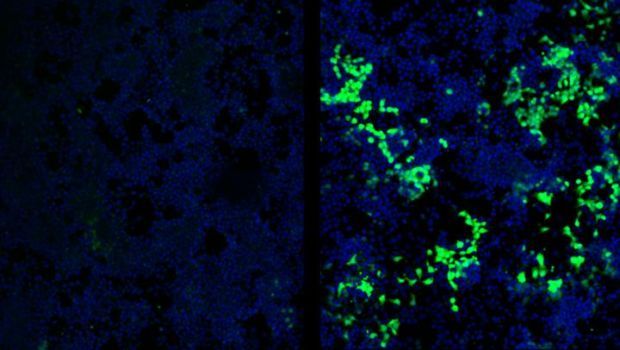Scientists Reveal How Stem Cells Defend Against Viruses
Scientists from the Institute of Molecular and Cell Biology (IMCB), a research institute under the Agency for Science, Technology and Research (A*STAR), Singapore, have uncovered the mechanisms which embryonic stem cells employ to inhibit virus expression. The ground-breaking discovery could potentially advance stem cell therapeutics and diagnostics.


Left: Embryonic stem cells with silencing of viruses. Right: Removal of silencing machineries Cha1fa and Sumo2 resulting in the activation of viruses (in green). Images courtesy of Jonathan Loh, A*STAR's Institute of Molecular and Cell Biology
Scientists from the Institute of Molecular and Cell Biology (IMCB), a research institute under the Agency for Science, Technology and Research (A*STAR), Singapore, have uncovered the mechanisms which embryonic stem cells employ to inhibit virus expression. The ground-breaking discovery could potentially advance stem cell therapeutics and diagnostics.
Several stem cell types including embryonic and haematopoietic stem cells are known to be capable of suppressing the activities of infected viruses and viral DNA residing in the host genome. This characteristic property, known as proviral silencing, however, has not been fully understood. In order to study this, a team of scientists from IMCB designed a novel assay which allowed them to screen all the genes present in embryonic stem cells.
Through the screening platform, the team identified 303 genes and elucidated 148 biological processes and pathways linked to proviral silencing, suggesting that proviral silencing is controlled by coordinated mechanisms involving multiple cellular pathways. Through a comprehensive analysis, the scientists concluded that two specific genes, Chaf1a and Sumo2, are the key factors linked to proviral silencing. The findings of the study were reported in the top-tier scientific journal, Cell.
Further studies on the roles of Chaf1a and Sumo2 in stem cell proviral silencing can shed new light on stem cells and virus biology that could translate into valuable therapeutic and diagnostic applications.
Dr. Jonathan Loh, principal investigator of IMCB, says, "This is the first detailed study on proviral silencing in embryonic stem cells, and it helped us gain a deeper understanding of stem cells and its unique proviral silencing ability. With the new insights, we can better identify the good stem cells and use them more efficiently and safely in clinical therapies. We can also devise diagnostic approaches by studying the activities of the virus DNA within stem cells in various diseased conditions."
Professor Hong Wanjin, executive director of IMCB, says, "Fundamental research on human biology seeks to understand crucial biological processes occurring within humans in order to bring advancement in therapeutics and improve lives. With the growing importance of stem cell therapy, this study is a fitting example of how upstream research can potentially benefit and shape its applications."
Source: Biomedical Sciences Institutes (BMSI)
Top 7 Infection Control Today Articles of 2024: Insights and Innovations
December 30th 2024From advanced sterilization methods to combating antimicrobial resistance, Infection Control Today’s top articles of 2024 delivered actionable strategies for safer healthcare environments and improved patient outcomes.
Revolutionizing Infection Prevention: How Fewer Hand Hygiene Observations Can Boost Patient Safety
December 23rd 2024Discover how reducing hand hygiene observations from 200 to 50 per unit monthly can optimize infection preventionists' time, enhance safety culture, and improve patient outcomes.
Redefining Competency: A Comprehensive Framework for Infection Preventionists
December 19th 2024Explore APIC’s groundbreaking framework for defining and documenting infection preventionist competency. Christine Zirges, DNP, ACNS-BC, CIC, FAPIC, shares insights on advancing professional growth, improving patient safety, and navigating regulatory challenges.
Addressing Post-COVID Challenges: The Urgent Need for Enhanced Hospital Reporting Metrics
December 18th 2024Explore why CMS must expand COVID-19, influenza, and RSV reporting to include hospital-onset infections, health care worker cases, and ER trends, driving proactive prevention and patient safety.
Announcing the 2024 Infection Control Today Educator of the Year: Shahbaz Salehi, MD, MPH, MSHIA
December 17th 2024Shahbaz Salehi, MD, MPH, MSHIA, is the Infection Control Today 2024 Educator of the Year. He is celebrated for his leadership, mentorship, and transformative contributions to infection prevention education and patient safety.